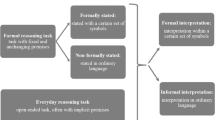Abstract
As is well known, it is important to enrich the basic deductive machinery of an interactive theorem prover with complex decision procedures. Previous work pointed out that one of the most difficult problems is the integration of these decision procedures with the rest of the system. In particular, they should be flexible enough to be effectively usable when building new proof strategies. This paper describes a hierarchical and modular structure of procedures which can be either invoked individually or jointly with the others. To each combination of procedures, there corresponds a proof strategy particularly effective for a given class of formulae. Moreover, the functionalities provided by the procedures can be exploited in an effective way by user-defined proof strategies, whose design and mechanization are therefore greatly simplified. The implementation of the procedures is described and the problems faced in embedding them inside the GETFOL system are discussed.
Similar content being viewed by others
References
M.A. Arbib, A.J. Kfoury and R.N. Moll,A Basis for Theoretical Computer Science (Springer, New York, 1981).
M. Abadi and Z. Manna, Nonclausal deduction in first-order temporal logic, J. ACM 37(1990) 279–317.
P.B. Andrews, Theorem proving via general matings, J. ACM 28(1981)193–214.
J. Van Baalen, The role of reformulation in the automatic design of satisfiability procedures, in:Proc. Workshop on Change of Representation and Problem Reformulation, ed. M.R. Lowry (1992) pp. 161–172.
R.S. Boyer and J.S. Moore,A Computational Logic, ACM Monograph Series (Academic Press, 1979).
R.S. Boyer and J.S. More, Integrating decision procedures into heuristic theorem provers: A case study of linear arithmetic, Machine Intelligence 11(1988)83–124.
A. Bundy, A. Smaill and J. Hesketh, Turning eureka steps into calculations in automatic program synthesis, in:Proc. UK IT 90, ed. S.L.H. Clarke (1990) pp. 221–226. Also available from Edinburgh University as DAI Research Paper No. 448.
R.L. Constable et al.,Implementing Mathematics with the NuPRL Proof Development System (Prentice-Hall, 1986).
A. Cimatti and F. Giunchiglia, Many sorted natural deduction, IRST Technical Report (1992), to appear.
N.G. deBruijn, The mathematical language automath, in:Symp. on Automatic Demonstration, Lecture Notes in Mathematics 125 (Springer, 1970) pp. 29–61.
B. Dreben and W.D. Goldfarb,The Decision Problem — Solvable Classes of Quantificational Formulas (Addison-Wesley, 1979).
T. Boy de la Tour, Minimizing the number of clauses by renaming, in:Proc. 10th Conf. on Automated Deduction (Springer, 1990) pp. 558–572.
M. Davis and H. Putnam, A computer procedure for quantification theory, J. ACM 7(1960)201–215.
F. Giunchiglia and E. Giunchiglia, Building complex derived inference rules: a decider for the class of prenex universal-existential formulas, in:Proc. 7th Eur. Conf. on Artificial Intelligence (1988). Extended version available as DAI Research Paper No. 359, Department of Artificial Intelligence, Edinburgh University.
F. Giunchiglia, The GETFOL Manual — GETFOL Version 1, Techical Report No. 9204-01, DIST — University of Genova, Genoa, Italy (1992). IRST Manual, IRST, Trento, Italy (forthcoming 1992).
M.J. Gordon, A.J. Milner and C.P. Wadsworth,Edinburgh LCF — A Mechanized Logic of Computation, Lecture Notes in Computer Science 78 (Springer, 1979).
F. Giunchiglia and P. Pecchiari, Riscrittura sintattica in GETFOL, Technical Report No. 9105-23, IRST, Trento, Italy (1991).
G. Gallo and G. Urbani, Algorithm for testing the satisfiability of propositional formulae, J. Logic Programming 7(1989)45–61.
F. Harche, J.N. Hooker and G.L. Thompson, A computational study of satisfiability algorithms for propositional logic, Working Paper No. 1991-27 (1991).
R.G. Jeroslow and J. Wang, Solving propositional satisfiability problems, Ann. Math. Artificial Intelligence 1(1990)167–187.
S.C. Kleene,Introduction to Metamathematics (North-Holland, 1952).
S.C. Kleene,Mathematical Logic (Wiley, 1967).
D.W. Loveland,Automated Theorem Proving: A Logical Basis (North-Holland, 1978).
S.J. Lee and D. A. Plaisted, Eliminating duplication with the hyper-linking strategy, Technical Report No. TR90-032, Department of Computer Science, University of North Carolina (1990).
N.V. Murray, Completely non-clausal theorem proving, Artificial Intelligence 18(1982)67–85.
G. Nelson and D.C. Oppen, Simplification by cooperating decision procedures, Technical Report No. STAN-CS-78-652, Stanford Computer Science Department (1978).
G. Nelson and D.C. Oppen, Fast decision procedures based on congruence closure, J. ACM 27(1980) 356–364.
D.C. Oppen, Reasoning about recursively defined data structures, J. ACM 27(1980)403–411.
F.J. Pelletier, Seventy-five problems for testing automatic theorem provers, J. Automated Reasoning 2(1986)191–216. See also Errata Corrige in J. Automated Reasoning 4(1988)235–236.
D.A. Plaisted and S. Greenbaum, A structure-preserving clause form translation, J. Symb. Comput. 2(1986) 293–304.
D. Prawitz,Natural Deduction — A Proof Theoretical Study (Almquist and Wiksell, Stockholm, 1965).
W.V.O. Quine,Methods of Logic (Holt, New York, 1959).
A. Robinson, A machine oriented logic based on the resolution principle, J. ACM 12(1965)23–41.
R. Shostak, An algorithm for reasoning about equality, in:Proc. 7th Int. Joint Conf. on Artificial Intelligence (1977) pp. 526–527.
C. Walther, A many sorted calculus based on resolution and paramodulation, in:Proc. 8th Int. Joint Conf. on Artificial Intelligence (1983).
R.W. Weyhrauch, Prolegomena to a theory of mechanized formal reasoning, Artificial Intelligence, Special Issue on Non-monotonic Logic 13(1) (1980).
Author information
Authors and Affiliations
Rights and permissions
About this article
Cite this article
Armando, A., Giunchiglia, E. Embedding complex decision procedures inside an interactive theorem prover. Ann Math Artif Intell 8, 475–502 (1993). https://doi.org/10.1007/BF01530803
Issue Date:
DOI: https://doi.org/10.1007/BF01530803




